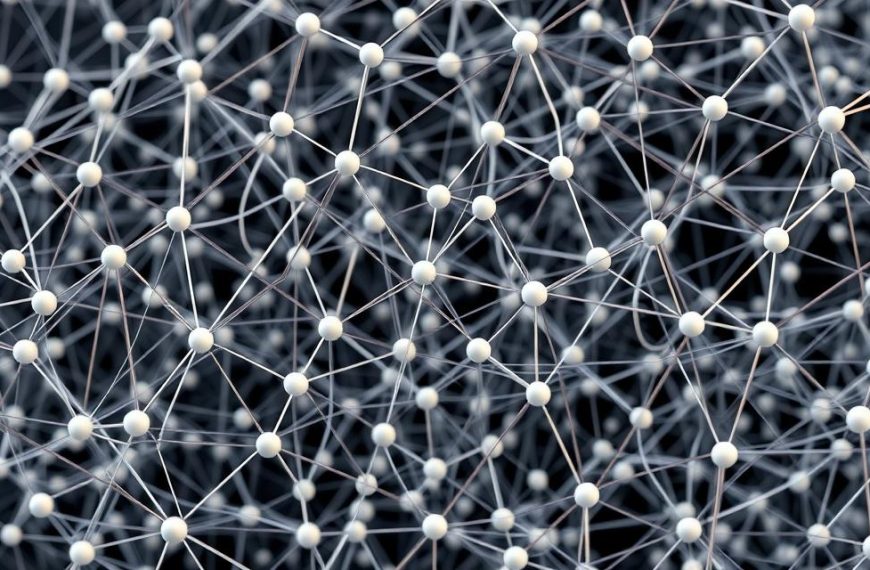Neural networks are powerful computational models inspired by biological brains. These adaptive systems excel at recognizing patterns and solving complex problems. From image recognition to predictive analytics, they drive innovation across industries.
The process involves seven key stages. First, install necessary frameworks like TensorFlow or PyTorch. Next, prepare your data through cleaning and normalization. Design the architecture carefully, considering layers and activation functions.
Training the model requires quality datasets and proper parameter tuning. After evaluation, optimize performance through techniques like dropout or learning rate adjustment. Finally, deploy your solution for real-world applications.
For detailed guidance, explore our neural network development tutorial. This resource covers practical examples like FashionMNIST classification and function approximation.
Introduction to Neural Networks
Unlike traditional algorithms, these adaptive systems improve through experience. They excel at uncovering hidden patterns in input data, making them indispensable for modern machine learning.
What Is a Neural Network?
A neural network is a series of interconnected layers that process information. Each layer transforms variables to refine predictions. For example, predicting house prices involves analyzing square footage, location, and market trends.
| Feature | Linear Regression | Neural Network |
|---|---|---|
| Handles nonlinear relationships | No | Yes (e.g., ReLU activation) |
| Learns from raw data | Requires manual feature engineering | Automatic feature extraction |
| Scalability | Limited by equation complexity | High (e.g., 90% accuracy on FashionMNIST) |
Why Use Neural Networks for Machine Learning?
They outperform traditional models in complex scenarios. ReLU activation enables modeling intricate relationships between dependent variables. For instance, image classification achieves higher precision with convolutional layers.
Training adapts to new data without reprogramming. This flexibility powers applications like fraud detection and medical diagnostics.
Prerequisites for Setting Up a Neural Network
Data quality determines model performance more than any other factor. Proper preparation involves both technical tools and analytical understanding. These foundations ensure reliable results during training and deployment.
Required Tools and Libraries
Modern frameworks simplify development significantly. TensorFlow and PyTorch lead the industry with comprehensive documentation. Both support GPU acceleration for faster computations.
Essential packages include:
- NumPy for numerical operations
- Pandas for data manipulation
- Scikit-learn for preprocessing
- Matplotlib for visualization
Understanding Your Dataset
The Neural Designer example uses 50 samples with two key variables. The input (x) represents features, while the output (y) contains target values. This simple structure demonstrates core principles effectively.
Standard practice splits data three ways:
| Split | Percentage | Purpose |
|---|---|---|
| Training | 60% | Model learning |
| Validation | 20% | Hyperparameter tuning |
| Testing | 20% | Final evaluation |
Normalization scales all independent variables to comparable ranges. The scaling layer in Neural Designer handles this automatically. This prevents features with larger values from dominating the model.
Correlation analysis reveals relationships between dependent variables and features. Strong correlations suggest predictive power, while weak ones may indicate noise. This guides effective feature selection before training begins.
How to Set Up a Neural Network: Step-by-Step
Building an effective model begins with proper setup and data handling. Follow these critical steps to ensure your foundation supports accurate predictions and efficient training.
Step 1: Install Necessary Software
Start by selecting a framework like PyTorch or TensorFlow. Both offer robust tools for managing variables and streamlining the process. Use pip or conda for installation:
pip install torch pandas matplotlibconda install -c pytorch pytorch
Step 2: Load and Configure Your Dataset
For tabular data, use Pandas to read CSV files:
import pandas as pd
dataset = pd.read_csv('data.csv')Image datasets require PyTorch’s DataLoader:
from torchvision import transforms
transform = transforms.Compose([transforms.ToTensor()])Key actions:
- Assign input (x) and target (y) variables.
- Visualize distributions with
plt.scatter(). - Normalize values to a 0–1 range.
Designing the Neural Network Architecture
The architecture of your model directly impacts its ability to make accurate predictions. A well-structured design balances complexity with computational efficiency. Key decisions include layer depth and activation functions.
Choosing the Number of Layers
Shallow networks (1–2 hidden layers) work for simple patterns. Deep architectures excel at complex tasks like image recognition. For MNIST datasets, 3–4 layers often achieve 95%+ accuracy.
Trade-offs to consider:
- Learning capacity increases with depth but risks overfitting.
- Training time grows exponentially with added layers.
Selecting Activation Functions
Hidden layers commonly use ReLU or tanh. ReLU avoids vanishing gradients and speeds up training. Tanh suits normalized data (-1 to 1 ranges).
# PyTorch implementation
self.hidden = nn.Sequential(
nn.Linear(input_size, 64),
nn.ReLU() # Or nn.Tanh()
)For output layers:
- Regression: Linear function (unbounded values).
- Classification: Sigmoid (binary) or Softmax (multi-class).
Sigmoid can cause vanishing gradients in deep networks. Modern neural networks often replace it with ReLU variants like LeakyReLU.
Configuring the Training Process
Optimizing the training phase separates functional models from high-performance solutions. Key decisions involve loss functions and optimization algorithms, which directly impact how weights adjust during learning.
Setting the Loss Function
The loss function measures prediction errors, guiding weights adjustments. Common choices include:
- Mean Squared Error (MSE): Ideal for regression tasks (e.g., housing prices).
- Cross-Entropy: Preferred for classification (e.g., image recognition).
“Selecting the right loss function is like choosing a compass—it determines your model’s direction.”
Choosing an Optimization Algorithm
Optimizers control how quickly models adapt. The method affects convergence speed and stability:
| Optimizer | Best For | Code Implementation |
|---|---|---|
| SGD | Simple tasks | optim.SGD(params, lr=0.01) |
| Adam | Most deep learning | optim.Adam(params, lr=0.001) |
Adam often outperforms RMSprop and SGD by adapting per-parameter learning rates. For advanced control, explore forward propagation and backpropagation techniques.
Learning rate schedulers (e.g., StepLR) adjust rates dynamically, balancing speed and precision during the process. This is critical when you train neural networks on large datasets.
Training Your Neural Network
Effective training transforms raw computational models into intelligent systems. This phase adjusts values within layers to minimize discrepancies between outputs and actual results. Tools like TensorBoard provide real-time feedback for precision tuning.
Running the Training Loop
Each iteration fine-tunes weights using backpropagation. The loss function quantifies error, guiding adjustments. For example, a 10% validation error suggests room for improvement.
“Training loops are the gym sessions for AI—repetition builds strength in predictions.”
Monitoring Training Progress
Track metrics like accuracy and loss across epochs. Plateaus indicate needed hyperparameter changes. Early stopping halts training if validation scores degrade, preserving resources.
- Save checkpoints of top-performing models.
- Compare training/validation curves for overfitting signs.
- Adjust learning rates dynamically for stalled process.
Consistent monitoring ensures reliable prediction capabilities. Modern frameworks automate logging, but manual reviews catch subtle issues.
Evaluating Model Performance
Validation reveals whether predictions match real-world scenarios. This critical phase measures how well your solution generalizes to unseen input data. Tools like directional plots visually compare expected versus actual output.
Testing on Validation Data
Reserved validation sets provide unbiased performance metrics. For image classification, analyze mislabeled examples to identify patterns. Common issues include:
- Low contrast features confusing the model
- Overlapping categories (e.g., shirts vs. sweaters)
- Background noise affecting accuracy
“Validation error rates below 5% typically indicate robust learning—above 15% signals need for architectural changes.”
Interpreting Results
SHAP values quantify feature importance numerically. Visualize decision boundaries with contourf() to spot underfitting. Key benchmarks:
| Metric | Good Range |
|---|---|
| Precision | >0.85 |
| Recall | >0.80 |
Consistent error patterns across samples often reveal data quality issues. Address these before retraining.
Improving Generalization Performance
Generalization separates theoretical models from practical solutions. When weights adapt too closely to training data, real-world performance suffers. Strategic adjustments maintain accuracy across diverse inputs.
Techniques to Avoid Overfitting
Dropout layers randomly disable nodes during training. This prevents over-reliance on specific values within the network. Like cross-training athletes, it builds adaptable systems.
Early stopping monitors validation loss. Training halts when performance plateaus, preserving resources. Common thresholds include:
- 5 consecutive epochs without improvement
- Validation accuracy drops >2%
Fine-Tuning Hyperparameters
Grid search tests combinations systematically. For batch sizes [32,64,128] and learning rates [1e-3,1e-4], it evaluates 6 configurations. Automated tools like Optuna streamline this process.
“Hyperparameter optimization is the difference between good and great models—like tuning a race car’s engine.”
Bayesian optimization predicts promising configurations. It analyzes loss landscapes to focus searches efficiently. Key metrics track:
| Parameter | Optimal Range |
|---|---|
| Batch size | 32–128 |
| Learning rate | 1e-4 to 1e-3 |
Each adjustment refines the model’s function without structural changes. Consistent evaluation ensures balanced performance across all data splits.
Deploying Your Neural Network
Deployment transforms trained models into real-world solutions. This phase bridges development and production, ensuring your system handles live input data reliably. Proper implementation maintains accuracy while scaling to user demands.
Exporting the Model
Frameworks provide export tools for different environments. TensorFlow uses SavedModel format, while PyTorch leverages TorchScript. For the FashionMNIST example, include preprocessing steps in the export.
Key considerations:
- Set output constraints using bounding_layer for value ranges
- Optimize for inference speed with quantization
- Include version metadata for tracking
“Model packaging is like spacecraft preparation—every component must work flawlessly in the target environment.”
Integrating into Applications
Flask provides lightweight API wrappers for web deployment. Containerization with Docker ensures consistent behavior across platforms. For enterprise systems:
| Component | Purpose |
|---|---|
| Prometheus | Tracks prediction latency and accuracy over time |
| Grafana | Visualizes performance metrics |
A/B testing frameworks allow safe model updates. Route 10% of traffic to new versions before full rollout. This reduces risk when systems make predictions on critical data.
Conclusion
Mastering the process of building a neural network requires attention to detail at every stage. From data preparation to deployment, each step impacts model performance. The right tools and iterative tuning make the difference between average and exceptional results.
This tutorial covered core concepts like architecture design and hyperparameter optimization. For deeper learning, explore advanced architectures like transformers. Hands-on practice with real datasets solidifies understanding faster than theory alone.
Remember, even well-designed models improve through continuous refinement. Test variations, analyze errors, and adapt. The journey from prototype to production teaches invaluable lessons no guide can fully capture.

















